How your brain constructs experience — 2. Elements of experience
How do emotions, intuition, attention, thought, memory, imagination and awareness fit together?
This is the second part of the series “How your brain constructs experience”.
Part 1 explained predictive processing as the central model grounded in neuroscience.
Top-down, we predict experience from mental maps modelled by memory.
Bottom-up, sense data comes in from body and world to confirm or correct.
When bottom-up sense data conflicts with top-down experiential construction, prediction errors and the map updates.
What follows is my own mapping of the model onto different features of experience.
Emotions
We start by modelling the world internally through emotions.
Emotions are grounded in affect, which is the general sense of feeling in the body. Specifically, affect is a felt summary of the sense data resulting from whatever your body (organs, hormones, immune system) is doing to anticipate metabolic needs.
Affect ranges from idle to aroused and pleasant to unpleasant. These basic states mirror the biological drives of fear and desire, whereby fear is reactive (avoid harm so to survive) and desire is active (seek benefit so to thrive and procreate).

Affective spectrum with mapped emotional concepts
Emotions, like joy and sadness and peacefulness and anger, are names we give to specific configurations of affect. They signal how to act in specific contexts relative to our past habits. If something made you happy in the past, you’re more likely to seek it again. If something scared you in the past, you’re more likely to avoid it this time.
In this sense, emotions are nebulous indicators of predictive calculations happening in the background. It’s how you feel the brain computing sense data from inside and outside the body through what it knows from memory for effective prediction. Affect is how you feel the body as function of what is going on inside of it (biology), emotions are what you conceptually categorise that feeling as (language, culture).
When emotions persist over longer periods of time, they fade into moods — felt less specifically than emotions.
The myth of "universal" emotions
This explanation of emotions runs counterintuitive to the classical (and still popular) view that emotions are hard-wired into our bodies. For example: when the body feels threatened or scared, it runs through an anger or fear pathway that evokes the same response every time in every one.
Yet, there is no evidence for universal emotional fingerprints.
Instead, research shows that emotions are simply how we linguistically label and interpret various hues of affect as it ranges between levels of (dis)pleasure and stimulation. They are concepts the brain contextually applies in prediction.
"An emotion is your brain's conceptual construction of what your bodily sensations mean, in relation to what is going on around you in the world." — Lisa Feldman Barrett
Categorising the complex storm of feelings inside of you "anger" anchors it as a specific experience that primes the way for action. It is also simpler to communicate, which is why we all seem to have the same emotions: they're culturally shared (or inter-subjective) concepts passed on to us as kids and constantly reinforced in social interaction.
Emotion concepts in fact vary across cultures. So much so that, for example, Eskimos have no equivalent concept for "anger" and Tahitians don't have one for "sadness." Under the hood, they'll feel similar hues of affect that correspond to those concepts in English but conceptualise them differently. Vice-versa, English has no versions of hygge (Danish), saudade (Portuguese), age-otori (Japanese), fago (Ifaluk), litost (Czech), tocka (Russian), or gigil (Filipino).
Learn more in Lisa Feldman Barrett's excellent How Emotions Are Made.
Intuition
Signalled through affect (interpreted as emotions), intuition non-linearly structures patterns in the chaos of sense data relative to actions.
Intuition springs from embodied cognition and operates without thought, which is why it feels like autopilot: constructed experience and executed behaviour come fluidly. It’s what the brain knows and predicts from memory without checking against sense data.
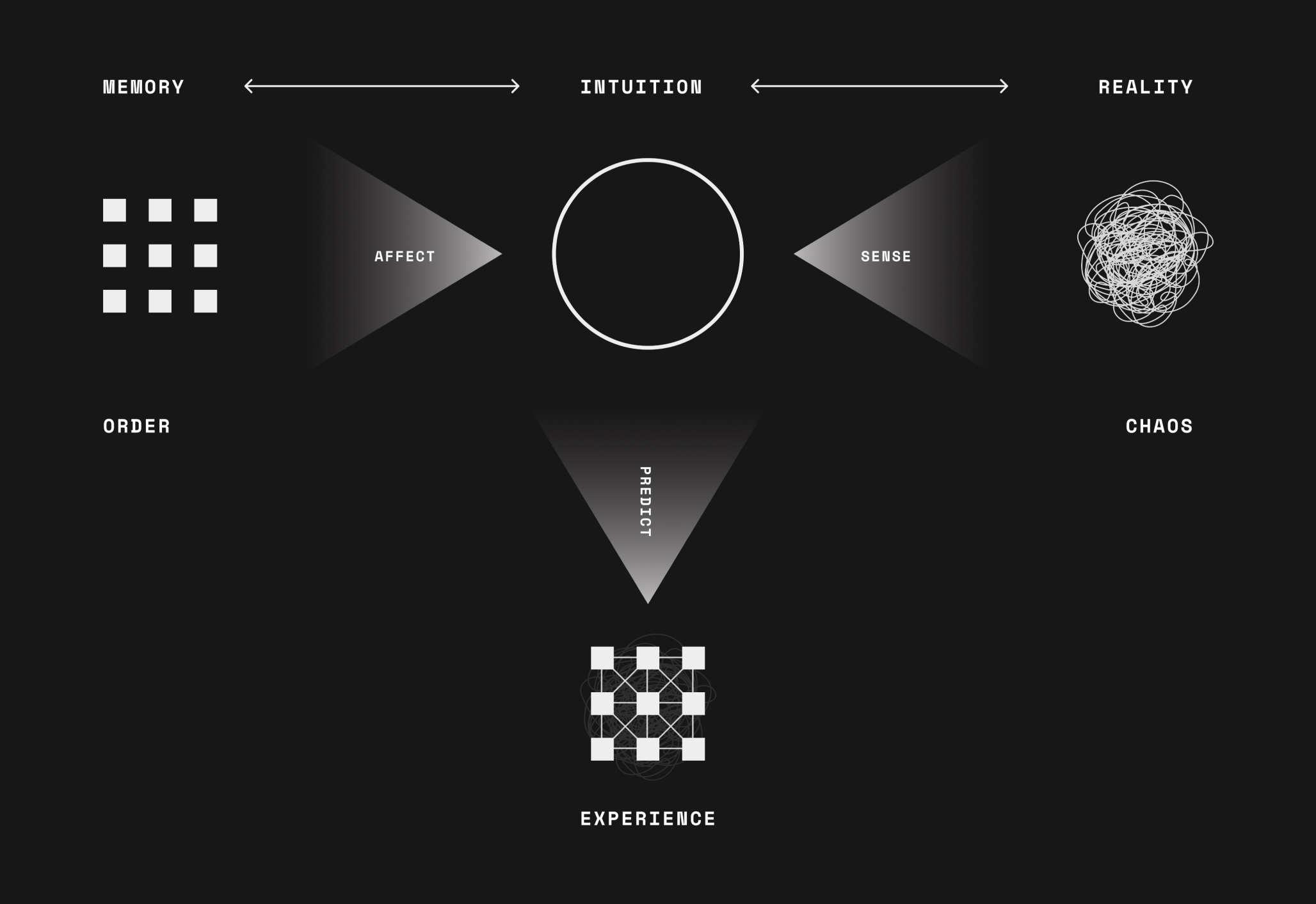
Intuition non-linearly structures patterns in chaos from what it learned in the past.
When the prediction accurately represents reality and executes effective behaviour, this intuition is wisdom. When the prediction is limited and executes misguided behaviour, this intuition is bias.
Attention
When a prediction errors against sense data, it shakes our intuition to update the underlying mental models. We experience a sudden shift in attention: the source of learning.
Attention is the brain focusing on uncertain elements in the environment, on top of what it assumes to already know. It’s always chasing novelty and surprise to seek out threats and opportunities. Since every moment has at least a small degree of novelty, attention can feel like it’s constantly scanning all over the place — which it is.
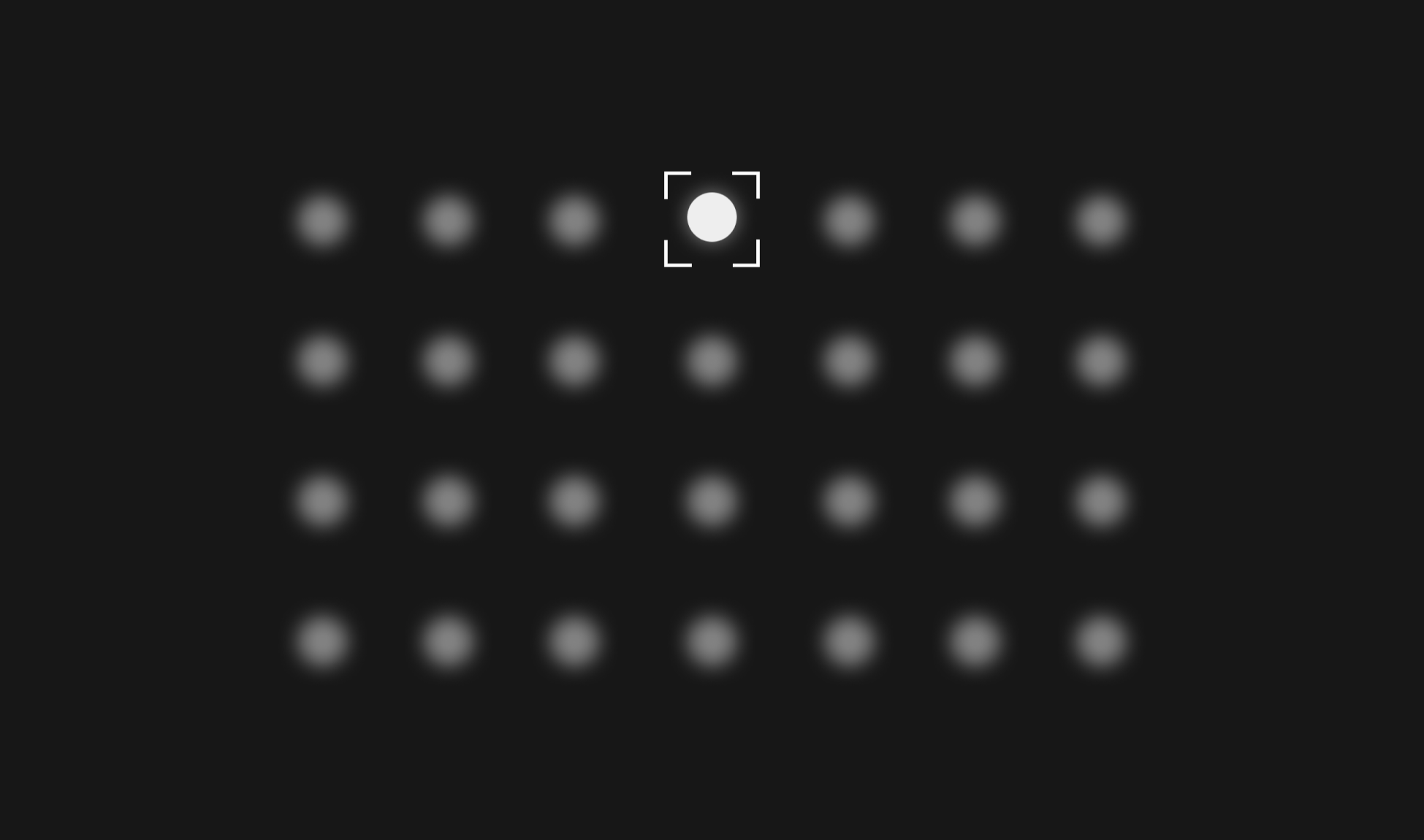
Attention is constantly scanning all over for novelty.
But attention can also find novelty and surprise by focusing in on something deeply, which creates the experience of flow. Rather than jumping between the most interesting distractions that come into the field of perception, this kind of focus actively changes perception by bending it around the subject of attention. Time spent in flow feels slower, richer, and more emotionally qualitative. (Part 3 further explores flow).

Focusing attention deeply can create the experience of flow.
Thought
Attention can be focused in a way that bends perception with intention,which is the product of thought.
Thought extends the goal-seeking behaviour of our basic drives. It is triggered by whatever emotion lies underneath to question it.

Thought enables us to reflect on and regulate emotions, consciously consider perceptions and granularise judgements as a result.
“Thoughts are the shadows of our feelings -- always darker, emptier and simpler.” — Friedrich Nietzsche

Thought packages feeling and perception using concepts, subjecting them to conscious consideration, reflection and imagination.
Grounded in language, it’s thought that unlocks abstraction; the conceptual compression of realities into mental LEGOs the brain can remix and combine to imagine new realities that exist in the mind alone. Through language we can furthermore share these mental models with other brains, networking them together in culture.
Within the brain, thought is generative: it can keep chaining from itself, though at the cost of becoming more abstracted from reality. Eventually, chains of thought inevitably get stuck in self-referential loops, channelling emotions in ways that are either destructive or productive — depending on the output.
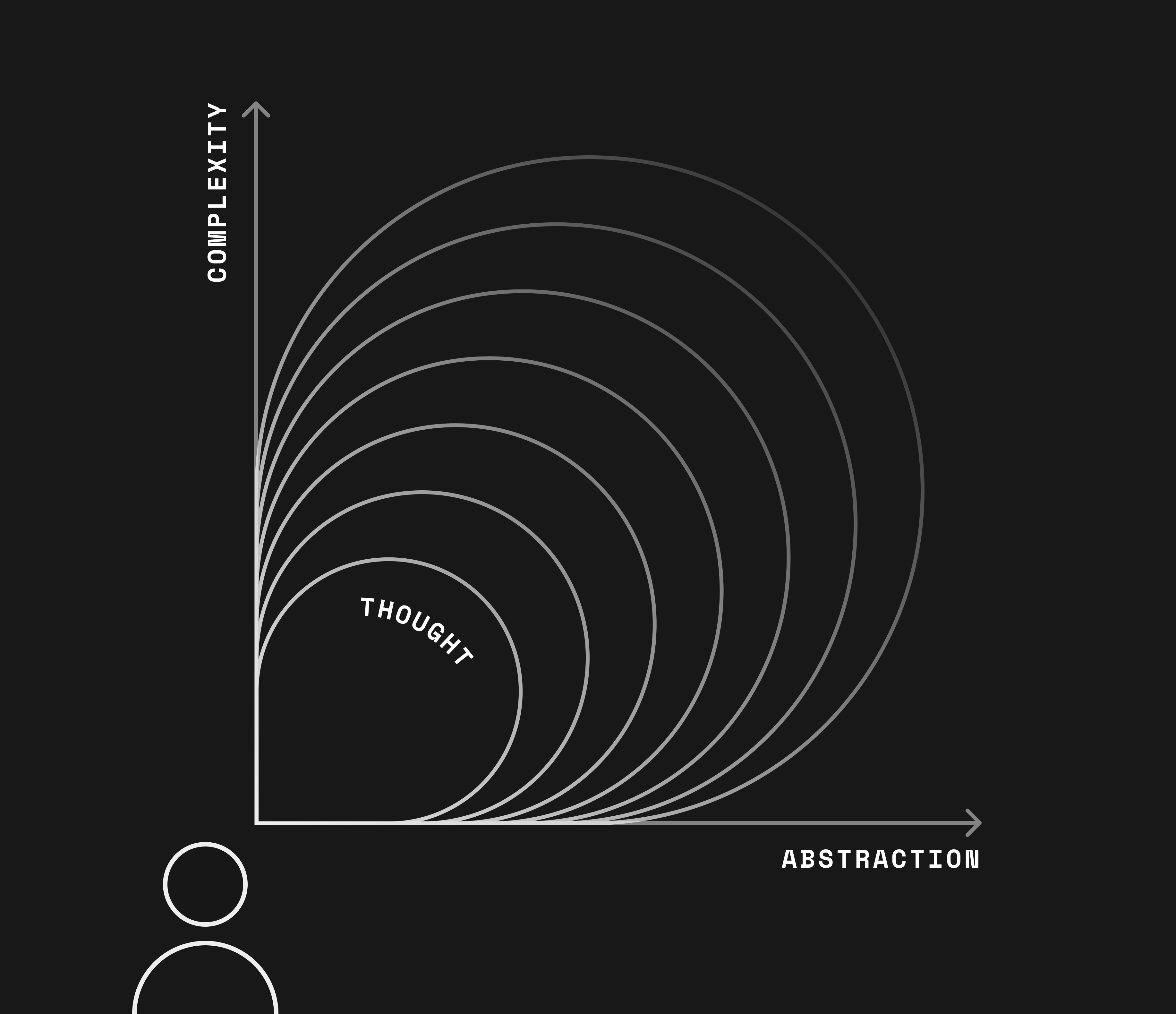
Thought can chain from itself but at the cost of abstraction from reality; and eventually loops back onto itself.
Memory and imagination
Reflecting on perception with thought splits perception into memory and imagination. Past and future, what has been and what can be.
Memory is accumulated mental modelling iterated on feedback from the world. It’s past experience stored through emotions felt at the time. Memory guides prediction and ensuing behaviour from what the brain believes to be important and true in any given context. When we learn through surprise, this is what it is being updated. It can also be changed by reflection.
Imagination, on the other hand, is mental modelling on top of memory; creatively recombining conceptual LEGOs to extend self-referential loops into possible scenarios for the future.
"What you can imagine depends on what you know." — Daniel Dennett

Imagination creates attractors: visions for tomorrow that pull action toward itself in the present. It’s what orders and orients creativity, driving it in a particular direction.
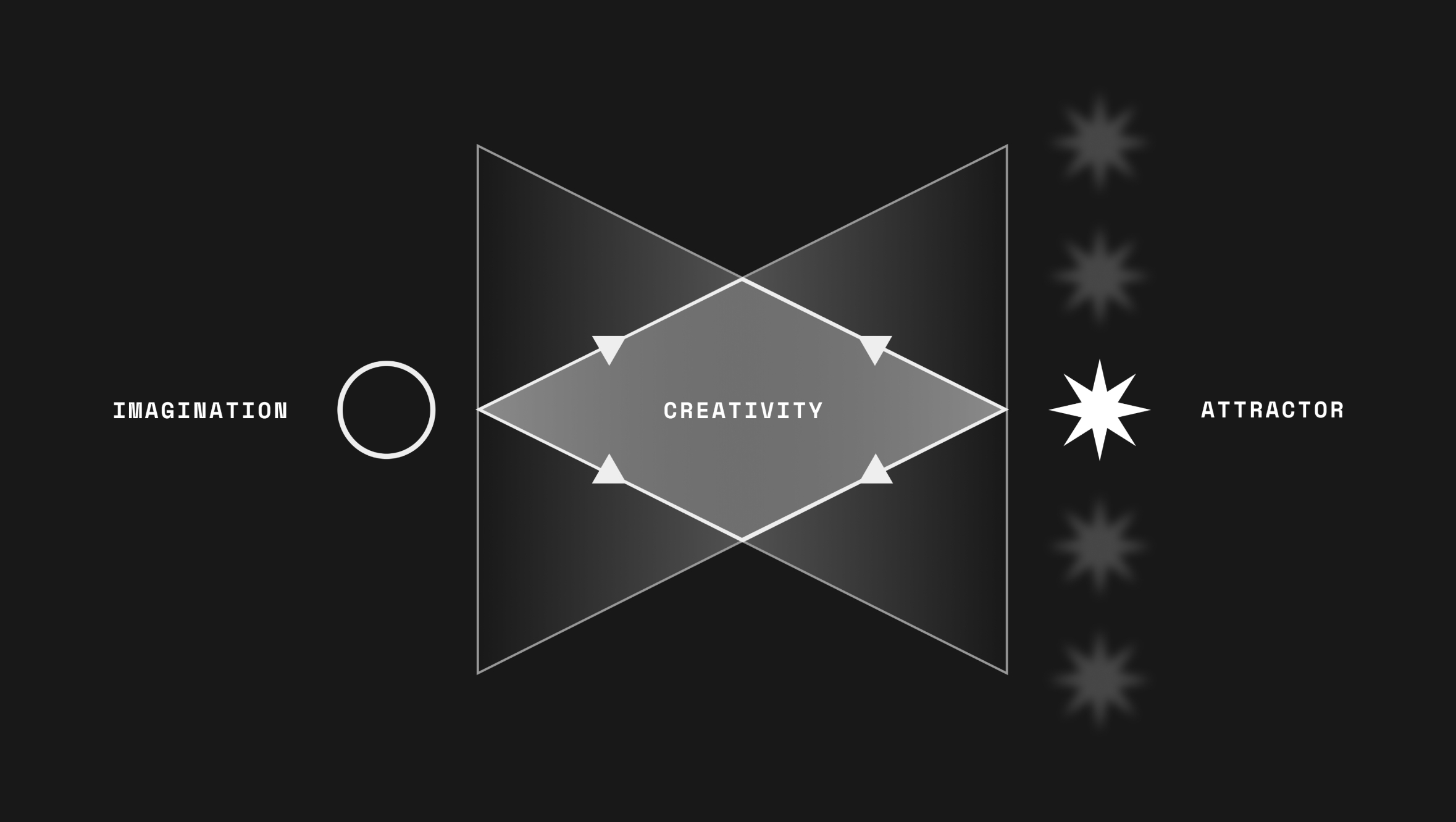
Imagination creates visions of the future that can pull attention in its direction, channelling creative impulse.
Both intuition and attention are rooted in memory and imagination, but intuition tends to be more strongly guided by memory and attention is more powerfully pulled in the direction of the vision being imagined.

Self
By creating loops of memory and imagination to split perception, thought creates what we experience as the self; something that clarifies the distinction between body and environment.

The self is the emerging experience of the body in its environment, computed in real-time as predictions correctively integrate with incoming sense data. It’s how the brain experiences itself in the present through the network of mental models it learned from the past. Through the prism of self, we predict, understand and interact with everything else.
Awareness
To step out of self-referential loops is to experience awareness.
Awareness can observe the different components of our self interacting in experience of the environment, uninvolved and without judgement. From the outside looking in, it can spot misguided habitual chains of interpretation impossible to see from within. Through awareness, you can come to understand your self better and orient it for growth with intention.
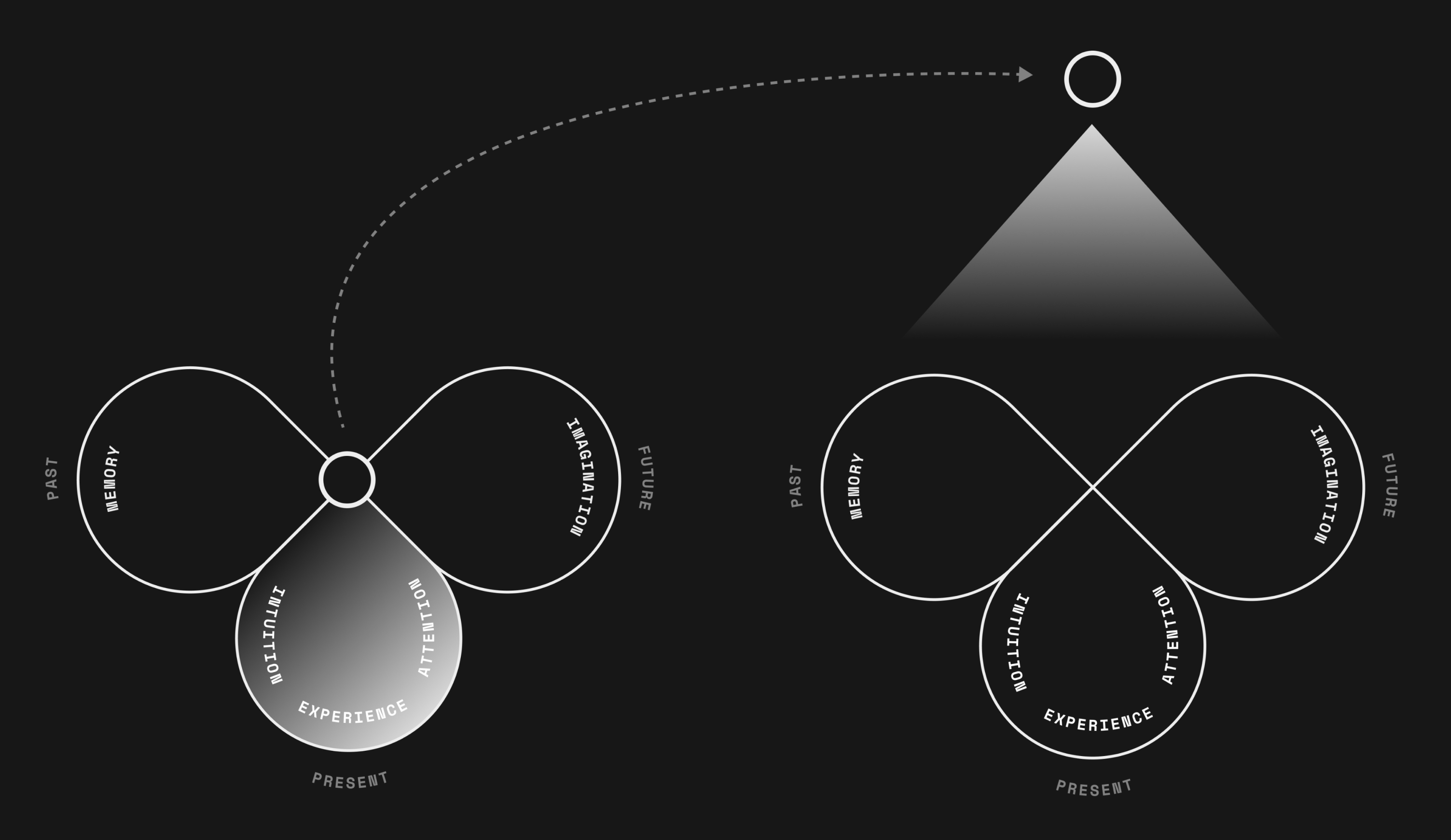
Awareness steps outside the self to observe its mechanics so to identify paths for changing them.
Awareness enables intentional learning, by directing feedback loops between self and environment. Whereas the brain by default seeks to minimise surprise and prediction error to save energy, awareness can seek them out.
Action
All these components network in ways too complex to precisely model. But they express into objective reality through action: speech and motor behaviour.

What we do and say is what others perceive and judge. They are the outputs of our internal models as measured by external agents. It’s what the moving parts predict and what awareness can observe through its detached lens.
The interplay between action and awareness determines the adaptive potential of the system: what it learns and how fast it learns.
Summary
In summary, the brain predictively experiences its self in the world through the perceptual model it accumulated from the past. Awareness can see its actions and retrace chains of interpretation for intentional learning. The self tries to minimise surprise. Awareness can maximize it.


